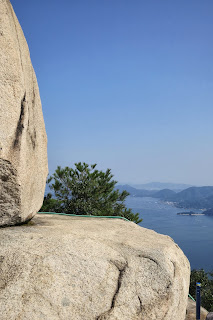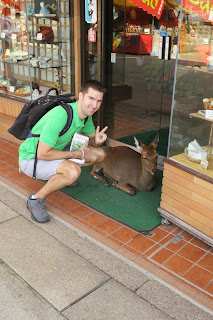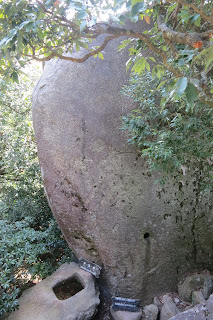The island's welcome wagon consists of deer. Yes, extremely tame deer. We even saw some deer jumping on people like dogs if they were carrying food items. Enjoy the pictures below. These deer wouldn't last a minute in Michigan. :)
 |
| The horned ones scared me. |
Once you get used to the deer, you can take in all the beautiful scenery. There are both Buddhist and Shinto religious buildings throughout the island. First on our path was a large building called Senjokaku. This means the 1000 mat pavilion, likely meaning that 1000 tatami mats would fit in this space. Tatami mats are a commonly used flooring material used throughout Japan, made of a soft rice straw. They are extremely fragile and absolutely no shoes are allowed on them, where ever you may find them. It is actually extremely rare that we live in a Japanese house that does NOT have a tatami room.
The building itself was meant to be a Buddhist library of sorts, but construction was stopped due to the builder's death, and was never completed.
 |
| Tatami Mat |
 |
| 1000 Mat Pavilion |
 |
| Artwork - rice scoops |
Besides it beauty, the island is known for its rice scoops. It even has... drum roll please... the WORLD'S largest rice spatula. I can cross that one off my bucket list. :)
 |
| There, now you have seen it too. The world's largest rice scoop. |
Mt. Misen is the the tallest point on the island, rising 535 meters above sea level. They have a "ropeway" - basically like a chair lift - that takes you up about 380 of those meters. The mountain itself is also sacred, and some Gods are still believed to reside here.
 |
| View from the ropeway |
 |
| Almost to the top! |
 |
| Views on the hike |
 |
| We made it! And...its hot. |
 |
| Views from the top |
Along the hike up, there were some interesting sights along the way, including some oddly shaped and named rock formations, etc. One of these, which we did NOT take the path to go see is called the Kaisen-iwa Rock - "SCABIES Rock!" Apparently, if you have scabies you have to hike the mountain and touch the rock which will take them off of you. Or, maybe it's a polite way of saying you should stay away from civilization and go climb a mountain. :) No way was I going near that thing.
One of the sites that I was afraid of visiting was the Kiezu-no-Reikado Hall. Otherwise known as Lover's Sanctuary, which houses the Kiezu-no-hi, or the eternal flame. This holy fire was started by the Buddhist monk who first climbed this mountain, and it has been lit ever since - over 1200 years. Water boiled by this fire is said to cure a variety of diseases. It is also the flame that was used to light the Flame of Peace at Hiroshima's Peace Park.
Another site is the Kanman-iwa - or the Ebb and Flow rock. This large rock has a hollow that is filled with water and is said to change its water level according to the coming and going of the tide. Didn't stay to find out - I'll just take the brochure's word for it.
Okay, I've saved the best part for last - the Torii. At low tide, you can walk right up to the torii, and at high tide it appears to be floating in water as the tide comes in even underneath the shrine that lies just inland. I put the pictures in progression - first ones at low tide in the morning, then mid tide in the afternoon and then high tide in the evening.
At one point, while out taking pictures in mid tide, we must have been out there longer than we thought because when we turned around to walk back - there was a good few inches of water creeping around us. Not wanting to get my shoes wet or my feet sandy to continue walking around in - Kenny picked me up on his back and carried me through the water. Apparently, the Japanese must not do this frequently because we had a whole bunch of Japanese tourists running up to us and taking our picture. It has got to be a classic picture, wish we could have seen it! :)
We haven't talked about food yet! Miyajima is known for 3 food items - 2 of which originated on the island. The first one that originated there was oysters grilled in the half shell. As mentioned in the previous post, Hiroshima/Miyajima island area is Japan's largest producer of oysters. They harvested 19,500 tons of oysters in one calendar year. This preparation of oyster is my new favorite.
Another dish Miyajima is know for is Anago Meshi - Rice with Broiled Conger Eel. A traditional fisherman's dish, this dish is a bowl or box of steamed rice topped with broiled eel that is seasoned with a special sticky soy based sauce. So. Good.
Lastly, Miyajima is known for Momiji-Manju. These are small cakes make into the shape of a maple leaf. The outside is maple/sweet flavored pancake like dough and inside is a variety of flavors. We snacked on these all day - 1 is about 80cents - and tried the traditional sweet bean paste, chocolate, raisin and cream cheese. Very good. They also have Age Momiji - which is fried Momiji-Manju.
Watch out though, the deer will eat these right out of your hand!
Another new dish we tried while on this vacation is Tsukemen. It is basically ramen with a twist - the broth and the ingredients are served separately. You pick up the ingredients and dip them into the broth and then eat. Another twist on the usual ramen is that the ingredients are often served cold. We had ours hot because it was a bit chilly out that day, but it is a good alternative in the summer when a hot steaming bowl of ramen is just too much.
Also, I'm not sure that was a chicken egg. I don't know what kind of animal it came from - but it tasted good and sometimes its best not to ask too many questions :P
That's all for now! Now that I'm back in Japan - it's time for more adventures and exploring! Until then! :)








































No comments:
Post a Comment